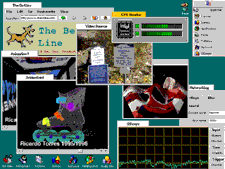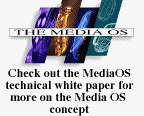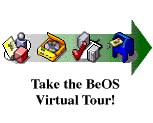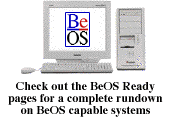
The Be Operating System Product Datasheet
BeOS Release 4
 As
the Internet expands, and as electronic media becomes more prevalent, the
high-performance needs of digital content design and the complex, aging
architectures of current mainstream operating systems are coming into conflict.
The BeOS is the first new operating system designed to unlock the door to
much more powerful personal computers, and extract more performance from
the systems we use today.
As
the Internet expands, and as electronic media becomes more prevalent, the
high-performance needs of digital content design and the complex, aging
architectures of current mainstream operating systems are coming into conflict.
The BeOS is the first new operating system designed to unlock the door to
much more powerful personal computers, and extract more performance from
the systems we use today.
The BeOS is based on a concept called the Media OS. It's not enough to add a few features and call an operating system a Media OS, an operating system needs to be designed to deal natively with digital media. The engineering team at Be didn't start with an existing OS and transform it, they started with the Media OS concept and optimized every portion of a new OS for handling digital media. The BeOS is designed to be the first, true, Media OS. And the BeOS is here today.
High-Performance
The power of microprocessors continues to advance, but the needs of digital content creators, and the applications they use, have outstripped even the speed provided by the latest processors. A media-oriented operating system can't rely simply on a single processor to handle the load.
The BeOS is designed for today's new generation of high-performance processors, and is optimized for the multiprocessor, media-based systems now emerging. Able to take full advantage of two, four, or more processors, the BeOS is based on a symmetric multiprocessing architecture which speeds operations, improves efficiency, and provides the foundation for a high-performance system.
But the BeOS takes multiprocessing a step further by employing pervasive multithreading throughout its design. Multithreading takes large tasks, such as applications, and breaks them down into a myriad of smaller tasks. Pervasive multithreading means that this approach is used throughout the BeOS, from the kernel, through the graphics and I/O systems, and through BeOS applications.
Pervasive multithreading is as fundamental a shift to software design as the introduction of the graphic user interface was in the early 1980s. No other current operating system implements pervasive multithreading throughout the system as completely as the BeOS has, providing the highest possible performance for media-based applications.
Preemptive multitasking allows the BeOS to work on, and rapidly switch between, dozens, often hundreds, of smaller tasks. These tasks can be deployed on a single processor, providing a smooth multitasking environment, or across any number of processors in a multiprocessor system.
Media Optimized
The BeOS doesn't stop with symmetric multiprocessing, pervasive multithreading, and preemptive multitasking. A media-optimized system must deal with very large data files, provide high performance graphics, and support high-efficiency, modular I/O capabilities. In each of these areas, the BeOS is more than up to the task.
 The BeOS employs
a native, 64-bit file system, allowing extremely large volumes and
files, of terabyte size and more, enough to handle even raw uncompressed,
high-resolution video and audio -- the foundation for high-quality editing
systems. The Be file system goes even further, providing database
capabilities allowing the storage of multiple attributes and indexes
along with files, with a query engine for performing dynamic
searches on those indexes and attributes. And the Be file system is a
journaling file system, providing added levels of protection against
corrupted files and reducing start-up time.
The BeOS employs
a native, 64-bit file system, allowing extremely large volumes and
files, of terabyte size and more, enough to handle even raw uncompressed,
high-resolution video and audio -- the foundation for high-quality editing
systems. The Be file system goes even further, providing database
capabilities allowing the storage of multiple attributes and indexes
along with files, with a query engine for performing dynamic
searches on those indexes and attributes. And the Be file system is a
journaling file system, providing added levels of protection against
corrupted files and reducing start-up time.
The BeOS provides a fully multithreaded graphics system, providing fast 2D and 3D graphics. Anti-aliased type is standard throughout the system. 3D capabilities are provided through the integrated industry-standard OpenGL® graphics library. And BeOS graphics capabilities are modular, allowing new hardware and software capabilities to be added by software developers.
The modular approach to graphics within the BeOS is also reflected in its I/O system. The BeOS provides a modular, dynamic, multithreaded I/O system, allowing drivers for new devices such as DVD drives to be dynamically loaded and unloaded, and allowing for on-the-fly reconfiguration.
Modern OS Features
The capabilities described above go beyond what you'll find in most mainstream operating systems today. Of course, the BeOS includes all of the buzzwords you'll find in articles about "modern" operating systems. The BeOS provides full preemptive multitasking, necessary for a multiprocessing and multithreading. Virtual memory capabilities are a standard part of the system, and are fully integrated with the multithreading capabilities to provide smooth application switching. And the design of the BeOS, from the lowest level through applications, uses object-oriented programming concepts.
 To prevent
you and your applications from sliding from the cutting-edge to the
bleeding-edge of software, the BeOS provides applications with full
memory protection -- meaning that if one application crashes, other
applications and the rest of the system are protected. The BeOS goes a step
further by using a client-server based internal architecture,
providing even further protection for applications.
To prevent
you and your applications from sliding from the cutting-edge to the
bleeding-edge of software, the BeOS provides applications with full
memory protection -- meaning that if one application crashes, other
applications and the rest of the system are protected. The BeOS goes a step
further by using a client-server based internal architecture,
providing even further protection for applications.
Internet Native
The BeOS is designed as an Internet-native system. At its foundation, the BeOS uses the TCP/IP networking protocols, the basic protocols of the Internet.
 The BeOS provides a
wealth of integrated Internet services. Any BeOS system can act as a
file server on the network, using the FTP protocols, allowing you to
share files with any other computer on the net. Mail and worldwide web
client services are built-in, as well as web server
capabilities, allowing you to publish web pages on the Internet or
Intranet from day one. And the BeOS even provides Telnet server
capabilities, allowing you to access your system remotely from
anyplace on the Internet.
The BeOS provides a
wealth of integrated Internet services. Any BeOS system can act as a
file server on the network, using the FTP protocols, allowing you to
share files with any other computer on the net. Mail and worldwide web
client services are built-in, as well as web server
capabilities, allowing you to publish web pages on the Internet or
Intranet from day one. And the BeOS even provides Telnet server
capabilities, allowing you to access your system remotely from
anyplace on the Internet.
And like its graphics and I/O capabilities, the BeOS networking system is fully multithreaded and modular, allowing you to add new high-speed network capabilities, and new network protocols and services, as they are developed.
Works with Your Current System
Most operating systems demand that you give up your current system and applications when you decide to switch. Not the BeOS. A wide array of Intel Architecture and PowerPC systems are capable of taking advantage of the BeOS. Many new systems will even come bundled with the BeOS
 The BeOS can
run side-by-side with Windows, Linux, the Mac OS, and other operating
systems. You can load several operating systems on your computer,
regardless of platform, and using the BeOS Bootman boot manager
switch between them at startup to access high-performance applications
within the BeOS, and your existing applications from those other operating
systems.
The BeOS can
run side-by-side with Windows, Linux, the Mac OS, and other operating
systems. You can load several operating systems on your computer,
regardless of platform, and using the BeOS Bootman boot manager
switch between them at startup to access high-performance applications
within the BeOS, and your existing applications from those other operating
systems.
And the BeOS goes further, allowing you to work with your other disk drives and files from within the BeOS, while retaining the capability of moving data back and forth between the systems -- and back and forth with your colleagues. Through the Internet you can exchange even more information with other users on Mac OS, Windows, and UNIX based systems. You can even print to any AppleTalk-based laser printers you might have on your Ethernet network.
BeOS: Creating the First, True Media OS
All of this only scratches the surface of the features you'll find in the BeOS. You'll also find the Tracker -- the core user interface of the BeOS -- which gives you access to the power of the Be file system as well as access to disks used by your other operating systems. You'll find Unicode support for international-ready applications and the Input Server to enable alternative methods for entering characters, including languages like Japanese.
You'll find Be's Replicant technology, which allows applications to merge parts of themselves into documents and other applications. For the more technically inclined, the BeOS includes a Unix/Posix compatibility layer and a fully functional command line with the bash shell. And more.
The BeOS is designed to be the first true Media OS. But the Media OS is a goal and a philosophy, the definition of a system that will keep evolving over time as we learn more about software and hardware design. There are always new applications and new levels of performance. Inherent in the BeOS is the ability to advance the operating system in a modular, dynamic manner -- even across the Internet. So as the needs of digital content design changes and evolves, so will the BeOS.
If you'd like to learn more about the BeOS, and the reality of a true Media OS, take a look at the details of the BeOS at Be's web site at http://www.be.com/products/.
All specifications subject to change without notice.
Information on the Be Operating System:
- Be's Media OS Whitepaper
- BeOS Data Sheet
- BeOS Specifications
- BeOS Tour
Copyright © 1999 by Be, Inc. All rights reserved. Legal information (includes icon usage info).
Comments, questions, or confessions about our site? Please write the Webmaster.